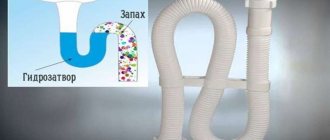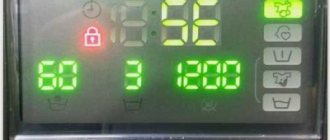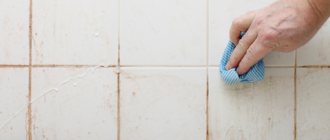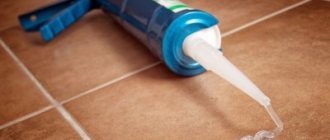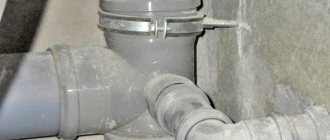Installation of sewerage in individual houses without centralized communications is the main condition for comfortable living of residents. During the operation of the system, various types of malfunctions are possible, which can be easily detected by the sense of smell; in this case, the owners will have to solve the problem of how to eliminate the smell in the sewer in a private house.
Options for eliminating unpleasant odors directly depend on the causes that caused them; in many situations, the owner can eliminate the defects on his own, but sometimes it is impossible to do without the help of specialists. In order to effectively eliminate odors from sewers without unnecessary financial expenses, it is useful to familiarize yourself with the causes of their occurrence and the main methods of control.
Rice. 1 Layout diagram of an autonomous sewer system
Reasons for the appearance of odor in a separate apartment
An unpleasant odor may come from plumbing fixtures located in a particular apartment.
This means that the search for the causes of its occurrence is narrowed to the boundaries of individual housing and, if possible, should be carried out by the people living in it. There are several reasons for the release of sewer odor (and it is important to determine as quickly as possible in which apartment it appeared). The cause may be a leak in the sewer pipes.
Its appearance is initially very difficult to notice even for a professional, since the practice of installing pipelines into a wall or floor (the so-called hidden placement) is common. The search becomes especially difficult if they are located in the ceilings between floors. Leaks can be detected using plumbing fixtures, and the problem can be eliminated by replacing the damaged pipe or sealing the damaged area (if it is small, then covering it with a high-quality cement solution is sufficient)
The cause may be a leak in the sewer pipes. Its appearance is initially very difficult to notice even for a professional, since the practice of installing pipelines into a wall or floor (the so-called hidden placement) is common. The search becomes especially difficult if they are located in the ceilings between floors. Leaks can be detected using plumbing fixtures, and the problem can be eliminated by replacing the damaged pipe or sealing the damaged area (if it is small, then covering it with a high-quality cement solution is sufficient).
If there is a need to replace a pipe, then when carrying out this process it is recommended to fulfill a number of requirements:
- use only high-quality connecting elements;
- minimize the number of joints that become sources of wastewater leakage;
- place pipe connections in places accessible for carrying out necessary repair work;
- carry out high-quality waterproofing of wall and floor surfaces in rooms associated with the active use of water (in the bathroom, toilet and kitchen).
The reason may be loose connections in the sewer pipe system. If the inspection has established it, then in order to eliminate the smell from the sewer system in the apartment, it is necessary to immediately seal the holes between the elements.
Often the cause of an unpleasant sewer smell is a poor-quality or broken connection to the plumbing equipment in the bathroom or kitchen (for example, to a sink or sink). In this situation, the solution would be a better reconnection or sealing.
Sometimes it is possible for water to dry out in the siphon elbows. This means that they do not contain a water plug (water seal), which, being in proper condition, successfully prevents sewer smell from penetrating into the premises of the apartment. In this case, it is necessary to check the siphon for serviceability.
Often there is a malfunction of sewer ventilation (which is accompanied not only by unpleasant sewer odors, but also by the “aroma” of urine coming from the toilet). This leads to damage to the water seals. The water plug they represent can be (due to the complete blocking of the pipe section by drains) pierced by air or pulled out of the siphon by it.
The reasons for this situation may be:
- the use of pipes for sewerage installations with a diameter reduced in comparison with that required by building regulations;
- laying pipes without maintaining the slopes required in such cases (2 cm per 1 m of pipe);
- complete filling of the lumen with sewage or ice, if the pipe is laid in a cold room (in the attic).
Depending on the specific cause, either changing the diameter of the pipe, cleaning it thoroughly, or (in the case of icing) rinsing it with hot water will help get rid of the blockage.
With the increasing use of shower stalls, a common cause of unpleasant odors emerging from shower stalls is the installation of corrugated pipe that does not form the elbow necessary to form a protective water plug. If such a situation arises, you need to create a water seal yourself by bending the pipe. We must not forget about its systematic cleaning.
Remedies
Video
Having considered the main factors that lead to the appearance of unpleasant odors in the house, let's talk about working on possible mistakes.
Installation errors
First of all, we will focus on eliminating faults that occurred during installation. To do this, it is important to understand the principles of the pipeline system:
- The toilet must be independently connected to a common riser, and lower than other equipment in the toilet, the connections for which are already installed comprehensively and on the same line.
- The outlet for the toilet should not be made narrower than the riser itself; the optimal option would be a diameter of 10 cm. It is recommended to select the dimensions of other connections based on the diameter of the outlet pipe from the plumbing equipment; they should not be smaller. Recommended diameter 7 cm.
- When installing the toilet, maintain a distance to the riser not exceeding one meter. Other equipment in the restroom is installed at a rate of no more than three meters to the common riser.
- In a situation where it is necessary to exceed the liner distance by three or more meters, it is better to use materials with a diameter of 7 cm or more.
Bacteria in cesspools cause a terrible stench to spread from any septic tank. To eliminate this problem, you just need to ensure proper operation of the entire system - there are no blockages, good drainage and a consistent slope and height difference, as well as carry out a number of preventive measures.
You should know that a bend with a diameter of 50 mm must have a horizontal slope of 30 mm/linear. m., 100 mm – 20 mm/linear. m.
The maximum permissible height differences should not exceed one meter for the toilet, and three meters for other equipment.
The most serious and common mistake that leads to the regular formation of system blockages is the use of ninety-degree angles for turns. But this can be avoided!
To ensure that water drains smoothly, angles should be set to one hundred and thirty-five degrees. By observing these simple conditions, you will forget about troubles and gurgling in your sink.
Faulty water seal
A plumbing water seal is mandatory when equipping any bathroom. As we have already said, the mechanism prevents the stench from entering the house from the sewer structure. It happens, for example, that you went on vacation and did not use the pipeline for about a month or two. During this time, the water in the siphon will evaporate, and access to the free passage of air will open. In this situation, it will be enough to pour some water into the drain to refill with liquid, and the aroma will disappear.
There are dry hydraulic seals that operate without water, the channels in which are closed with a float. The mechanisms are driven by spring pressure or their own weight. A malfunction of such devices can be caused by an accidentally ingested solid fragment. A large amount of drained water, for example from a bucket, will help solve this problem and remove air.
Cleaning up leaks
So, let's fix the leaks! First, it is necessary to inspect the entire pipeline, this also applies to those areas that are located under frame structures. If a water leak exists, you can easily detect it by wet spots, and in some cases, by mold on the finish.
Well, call a plumber; most likely, you will have to change the pipes and dismantle the plasterboard walls, which are already emitting a bad odor.
Ventilation problems
As a rule, sanitary facilities are characterized by high humidity, which leads to the formation of mold and bad odors. Problems with ventilation in the bathroom and toilet very often arise due to clogging of the existing hood. To check the ventilation shaft for functionality, it is recommended to hold a piece of paper to the hole. If it starts to be attracted to the channel, then everything is fine, the air is circulating, otherwise you will need to clean it.
It is very convenient to additionally install a ventilation valve, which will make the existing natural ventilation more powerful, provide better injection of clean air and remove sewer stench.
Causes of unpleasant smell from sewerage
The sewer system of any home is designed to remove various sewage: human waste products, dirty water after washing, washing dishes, and wet cleaning. The remains of spoiled food are sometimes flushed down the toilet.
The process of waste decomposition occurs with the help of putrefactive bacteria, and a significant amount of hydrogen sulfide is released. This foul-smelling gas comes from sewer pipes.
You should not put off eliminating this problem for too long - upholstered furniture, carpets, curtains or other home textiles quickly absorb all kinds of odors, accumulate them, and then it is difficult to get rid of the barely noticeable but persistent stench. Hydrogen sulfide, methane, and mold released into the air can cause allergic reactions in households, attacks of bronchial asthma, and, in high concentrations, poisoning.
To effectively eliminate a specific smell from the sewer system in an apartment, you need to find its source. The main causes of stench:
- clogged pipes and siphons;
- lack of a water seal;
- ventilation system problems;
- presence of hidden leaks;
- improper installation of plumbing structures.
Leaks – we eliminate microcracks and leaks
Pipes often leak at the joints, and an unpleasant odor spreads into the room. We eliminate leaks depending on the cause of the leak. If the pipes have shifted, we restore the correct position. On plastic pipes, for various reasons, rubber sealing rings fail, which we replace or treat the joints with sealant. On cast iron joints we also use silicone sealant or, if they are located horizontally, cement mortar.
To eliminate a leak in a plastic pipe, drain the water and dry it. We prepare a patch from a pipe of the same diameter: cut a piece of the required length, cut it lengthwise. Near the place of the crack or rupture, apply a layer of glue suitable for this material. Apply the patch and press it. If a crack is found at the joint, apply a layer of silicone, oil paint, and glue to it. We wrap it with tow, a bandage, and apply a water-repellent layer on top.
We repair cracks in cast iron pipes using epoxy glue or cold welding. We wrap the area around the crack with a bandage soaked in epoxy and fix it. You can also use a piece of thin rubber, which we wrap around the leak area and secure with wire or a clamp. The absence of high pressure will ensure reliable sealing even in such simple ways.
Methods for improving the smell in an apartment
You have fixed all the problems with the pipeline, increased the ventilation of the premises, but the heavy, musty smell is still noticeable. At the last stage of the struggle, add products that have a pronounced pleasant aroma. Aromatherapy will help improve the atmosphere of the apartment, fill it with comfortable tranquility, or, conversely, add vigor and a feeling of celebration.
Store flavors
On the shelves of retail chains you can find many products for aromatizing the air in the apartment. These can be sprays, diffusers (transparent bottles with aromatic liquid and bamboo sticks inserted into it), scented candles, aroma lamps with essential oils, automatic sprayers. Their purpose is to make the indoor air pleasant to our sense of smell. All of them mask bad sewer fumes, but do not affect the source of their occurrence. Neutralizers and absorbers of unpleasant odors stand separately. They are small devices filled with some kind of absorbent component. Air enters the neutralizer through numerous holes, where it is cleaned of harmful impurities.
Strong-smelling products at hand
Folk remedies will help make your home atmosphere more comfortable. Rooms with high humidity can be refreshed by placing small containers filled with coarse sea salt mixed with a few drops of any essential oil. Salt will remove excess moisture, and essential oil will fill the room with a light aroma. Coffee beans, citrus peels, and dry herbs have a rich aroma. They are poured into bowls or packaged in sachets made from natural fabrics.
Placed in different parts of the home, such environmentally friendly fragrances will give the apartment a subtle, subtle smell.
Cleaning
Thorough cleaning and regular ventilation of the premises will help improve the air in your home. Modern cleaning products successfully remove any dirt from plumbing fixtures. Apply the cleaning gel to the earthenware surface of the toilet bowl - it will instantly dissolve the limescale deposits. Antibacterial components of detergents suppress the proliferation of microorganisms and prevent the appearance of unpleasant stench from the bathroom. Don’t forget about preventing blockages: cover the drain holes of the kitchen sink or shower stall with special meshes - this will protect the siphons from small debris. At the first signs of blockages, try to clean the siphons with any preparation that dissolves organic matter. They are produced in the form of a solution, thick gel, and dry granules. Otherwise, the unpleasant smell of sewage will fill the house.
Get rid of excess dampness: after washing, leave the washing machine door ajar, do not dry laundry in the apartment, and equip the bathroom with additional ventilation. If you have pets, keep the litter box clean. Change the filler more often, disinfect the tray and the floor around it. Special aerosols will help neutralize the smell of urine.
The article has been verified by the editors
Incorrect operation of the washing machine
The reason for the specific “aroma” may be a familiar unit - an automatic washing machine.
With insufficient care, colonies of fungi and microorganisms can settle in the washing machine drum, causing unpleasant odors in the room
The odor may be caused by the following reasons:
- Incorrect connection of the device to the hydraulic valve, causing waste to enter the system. To fix it, it is better to disconnect the hose from the sewer, leading it to the toilet or sink.
- A clogged drain pump filter (most often it is located at the bottom of the machine). Sometimes, to eliminate an unpleasant odor, it is enough to clean this part.
- Plaque on the walls of the tank or tray for detergents, which is caused by the development of mold and other microorganisms on the surface. To eliminate them, it is important to regularly clean the components of the washing machine with disinfectants, vinegar, and citric acid.
To prevent a useful unit from poisoning the atmosphere with a stench, it is important to follow the rules for caring for this type of household appliance. It is advisable to periodically turn on a high-temperature washing mode, which allows you to get rid of harmful fungi and bacteria.
The best way to permanently get rid of the possibility of an unpleasant odor from the washing machine is to connect it to a bottle siphon under the sink in the kitchen or under the sink in the bathroom:
Image gallery
Photo from
Step 1: Preparing the washing machine hose for connection
Step 2: Location of Hose Outlet for Connection
Step 3: Connecting the drain hose to the siphon
Sealing ring for drainage
Why there is an unpleasant odor from sewer networks
There may be a sewer smell in your apartment for several reasons; you can fix some faults in the utility networks yourself.
Problems with the general sewer system at home
The following reasons may contribute to the appearance of an unpleasant odor:
- Improper installation of sewer pipes. If the norms are ignored, the system cannot work normally. When pipes are laid at an incorrect angle, wastewater stagnates, which allows foul-smelling gases to penetrate into apartments. This problem can also arise when replacing an old pipeline with a new one.
- Faults in the basement sewer system. When a pipe is damaged, wastewater leaks out, emitting a strong odor. In this case, there is a sewer smell on the lower floors of the building.
- General system clogged. Occurs when large debris is dumped into plumbing fixtures that are not intended for this purpose. In this case, not only does a stench appear, but pathogenic microorganisms also spread.
Problems with the operation of sewerage networks in an apartment
If sewerage stinks in the bathroom and toilet rooms, the reasons lie in malfunctions of the apartment drainage system.
Blockage in the drainage pipe.
These include:
- Pipeline damage. Metal elements corrode, causing leakage. Even a small hole allows foul-smelling gases to pass through. Damaged areas may be embedded in walls or floors and may not be easy to identify. Less commonly, cracks and chips occur on plastic pipes.
- Incorrect operation of the water seal. All drains located under bathtubs and kitchen sinks should be checked. They look like curved pipes containing a certain amount of water. When the siphon overflows with waste, the water seal drains into the sewer. A dry appliance cannot prevent gases from entering the room.
- Increasing pressure in the system. If this indicator exceeds the normal value, gases begin to enter the apartment. This situation can arise with a one-time discharge of a large volume of water, due to which the water seals are deprived of a water barrier.
- Clogged sewer pipe. Contributes to improper operation of drainage devices and the release of gases into the room.
- Clogged drains. Household waste stagnating in the flask begins to decompose, emitting an unpleasant odor. Water flows slowly, which prevents it from flushing the system.
- Installation of pipes of the wrong diameter. If neighbors on the top floor are renovating and using smaller elements, in winter there will be problems with ventilation of the drain pipe. The siphon seal may disappear when the toilet is flushed.
- Clogged drain hoses of washing machines and dishwashers. Contaminated areas become sources of fungus and mold. Particles of food, tissue, and hair contribute to clogging of hoses. They begin to decompose, emitting an unpleasant odor.
The constant penetration of sewer smell is fraught not only with discomfort, but also with the development of chronic diseases among residents.
Why are sewer gases dangerous?
The consequences of the spread of fetid gases in the apartment are:
- Damage to property. The sewer smell disturbs residents and is absorbed into furniture, decorative wall decoration, clothing, and food products. It is difficult to eliminate; air fresheners with a pronounced aroma only temporarily solve the problem.
- Poisoning of residents. When food waste breaks down, toxic methane gas is formed, which negatively affects human well-being. If large volumes of the substance are released, an explosion may occur. No less dangerous is hydrogen sulfide contained in wastewater.
- Development of chronic diseases in residents. Fungus and bacteria that spread when the sewer is clogged cause allergic reactions, dermatological pathologies and asthma.
Smells due to clogging, causes of formation
The main cause of clogging is two factors.
The first is the components of grease in the kitchen sink. They are gradually deposited on the walls of the pipes, reducing the clearance and preventing the flow of sewage water. Solid components of the drain actively accumulate on these obstacles. The second cause of clogs is hair, animal dander, and fibrous components that get into the pipes from the washing machine drain. They can form quite strong plugs that cannot be removed with simple techniques.
Let's imagine a sewer network in which plumbing fixtures are connected in series:
- kitchen sink;
- washbasin in the bathroom;
- a bathtub into which the washing machine is also drained;
- toilet.
All objects are equipped with siphons. How to determine the location of the plug?
We identify a blockage in the kitchen sink and remove it
We turn on the water from the tap at the sink. If water accumulates in it and does not drain, it means that the blockage is located either in the siphon or in the pipe between it and the washbasin connection. In the first case, you need to disassemble the siphon and check its condition.
If there is a blockage in the siphon, you just need to clean it and wash all parts with water and detergent. Then assemble this device and retest it with water. If she leaves freely, the problem is solved.
If the result is negative, you will have to clean the pipe with a plumbing cable. True, before this you can pump the sink with a plunger, which will destroy the plug and, for some time, restore the flow. However, this method is not considered cardinal.
The washbasin is clogged, how to fix it
A sign of this phenomenon is the filling of the sink. If this happens only in it, you need to clean the corresponding siphon, as shown above. And when filling the sink and sink at the same time, the place of clogging is between the sink and the bathtub in the common drain pipe. Here it is also necessary to use a cable to destroy the cork.
The bathtub is clogged
The most common cause of a blockage in a bathtub siphon is hair or animal fur. In the drain flow, these elements cling to the drain grate, forming a strong conglomerate. You can clear such a blockage in a simple way.
This plug can be easily removed with a wire hook when the siphon grille is removed. Removal of contaminants inside the drain pipe is carried out with a cable.
The toilet is clogged
This is perhaps the most serious incident that can happen to the sewer system in a private home. The appearance of a blockage, as a rule, is a consequence of the lack of discipline of the owners of a private house.
From the toilet siphon, water flows into the riser pipe, which is larger in size compared to drain pipes. The most “popular” one in this area is clogged with a rag. In this case, the contents of the riser come out and the smell in the toilet is determined by the contents of the sewer. Find out what to do when the toilet is clogged, popular ways to solve the problem.
Fan pipe. Eliminate sewer smell in the house and area
It is very difficult to remove such a blockage on your own, therefore, most often, outside specialists are invited with their equipment.
Problem with the water seal
When the section of the sewer pipe is completely filled with waste water, the water plug is removed. The absence of a water seal or its poor functioning can be called the most common reason for the appearance of an unpleasant odor in the bathroom. A water seal is a water plug in a siphon under plumbing fixtures. It serves as a kind of barrier to sewer gases. In the absence of this barrier, gases freely penetrate into the bathroom and the entire house or apartment smells like sewage from the toilet.
Let's further figure out how to eliminate the smell of sewerage in an apartment if the cause has not yet been found. Each toilet has basic plumbing equipment - a toilet bowl, under which there is also a siphon. In this case, the siphon is a curved pipe in the bend of which liquid can accumulate. Such a water seal serves as a fairly effective barrier to unpleasant odors from the sewer system.
The slightest deviations in the operation of the siphon cause the constant presence of sewage smell in the toilet. If the siphon has ceased to perform a barrier function, then this happened for one of the following reasons.
Reasons why your house smells like sewage
1. In most cases, the reason why a house or apartment smells like sewage is due to improper design of the sewer system:
- There is no fan ventilation, which is necessary for purging the sewerage system. This system is made in the form of an upward extension of the riser; it goes out through the roof of the house. The diameter of the drain channel must be equal to the size of the riser. To install a ventilation system, the building must be designed in such a way that it has an insulated shaft.
- There is no head on the fan pipe. Because of this, debris may get into it or birds will build a nest and block the hole. Also, the air flow may begin to move in the opposite direction if there is strong wind outside.
- The fan outlet is located at an insufficient height, so an unpleasant odor periodically appears near the emission area.
- The distance from the living space to the sewer ventilation outlet is up to 4 m, so the house smells like sewer.
- Ventilation of an external sewer system, for example a septic tank or cesspool, is located at a short distance or is located against the prevailing wind direction (this parameter is determined by the wind rose of the area), due to the movement of the air flow an unpleasant odor reaches the cottage.
2. Breakdowns during operation.
- The siphon broke. It is installed in the drain area to prevent sewer gases from entering the house.
- The siphon has a bend in which water is located. It acts as an obstacle between the sewer system and the room. A breakdown can occur if there is a volley discharge of wastewater through the riser. When the diameter is too small, water will fill the cross-section of the passage: due to the formation of a zone of low pressure, water from the siphon will go down. The water plug will sink into the sewer system, and the smell will begin to penetrate the house.
- The siphon is dry. This can happen if you do not live in the cottage permanently. When the sewer system is not used, the water seal in the siphon dries out, which means that unpleasant odors will begin to penetrate from the drain into the room. How to fix this problem? The only solution is to prevent drying out. Ask your neighbors to flush water down the drain every 7 days to keep the water plug from drying out.
- The siphon is broken. If you use the siphon incorrectly, leaks will appear due to the fact that small cracks have formed, or because it is not screwed onto the threads in the connection area. To prevent this from happening, you should handle the siphon with care.
3. The house smells like sewer because the system was not installed correctly.
In order for the drainage system to function correctly, errors must not be made during its installation. Please note the following points:
- Plumbing fixtures are placed incorrectly. The sewer design should be designed in such a way that the toilet, sink and bathtub are located linearly. It is important that the exit from the toilet is as close as possible to the riser. Drainage equipment on all floors in the cottage should be placed parallel in the same vertical plane.
- Every plumbing facility must have a siphon. Otherwise, unpleasant odors will begin to emanate from the drains.
- It is important to choose the correct diameter of sewer pipes. The size of the conductors must be such that drains flow freely through them. Most often, in country houses, gravity-flow systems made of plastic pipes are used. The further the pipe is from the drain source, the larger its diameter should be. For example, when the drains from the sink go through a 5 cm pipe, the riser should be 10 cm in diameter, the pipes leading to the VOC should be 15 cm.
- The connections in the drain system are not made correctly. If the system is gravity-fed, plastic socket products are suitable. Sealing collars should be placed in the socket. When mating occurs off-axis, the seals may become leaky. As a result, leaks and an unpleasant odor will appear, which will be quite easy to eliminate.
- The pipeline was installed without observing slopes. Remember that the slope should be 1-2% from the horizontal towards the drain. This means that over 1 meter of length the slope should differ by 2 cm per meter of length. Otherwise, the wastewater will not be able to drain. If you make the slope greater, the water will flow too quickly, as a result of which solid contaminants will no longer be washed away by the flow. As a result, due to their accumulation, the sewer will become clogged.
- Leaks have appeared in the sewer pipes, as well as areas where plumbing connects. The reason is the formation of small cracks, depressurization of connections. This happens most often due to improper installation of the sewer system, low-quality materials, and equipment breakdowns over time.
4. The house smells like sewage because the pipes are not installed and connected correctly.
When arranging a sewer system, it is important to ensure that the pipes are laid rationally. What does this mean:
- The gravity-type drain pipeline should not have many bends. Only in this case will the drains drain quickly, and the sewer will not become clogged with solid waste.
- Angled connections must be made using fittings with an inclination of 135° or 150°. The pipes must be connected at a slope in the direction where the water flows.
- Do not connect pipes at an acute angle, otherwise wastewater will not flow out.
- When installing a drain system, it is important to ensure that the pipes are aligned with the connecting fittings and pipes. Otherwise, tension will appear at the socket joint, which will result in the pipe cracking and depressurizing. Do not forget about the quality of the seals used when installing socket pipes: if a misalignment occurs, a leak will appear.
- The closer to the outlet, the larger the diameter of the pipes should be. For example, the receiving pipe to which the siphons are connected may have a diameter of 5 cm, the riser should be 10-11 cm, and the external sewer outlet should be 12-15 cm.
This is interesting!
What to add to the septic tank to prevent it from smelling: a review of basic equipment Read more
Follow these recommendations to properly equip the sewage system in your country cottage.
5. The house smells like sewer due to the water seal.
Why does my new house smell like sewer? This can happen due to the fact that the water seal allows unpleasant odors to pass through. The reason lies in the fact that the water in it has dried up. This happens when no one lives in the cottage for a long period. But if you start using the sewer system again, the water seal will fill with water and prevent unpleasant odors from entering the room.
This problem most often occurs in bathhouses that are used infrequently, in country houses when their owners rarely come.
How to prevent sewer smell from appearing in this case? The water seal should be replaced with a dry one. It is made in the shape of a ball; it is used to plug the sewer. However, this solution is not suitable for a toilet.
Why else might a water seal not do its job? Sometimes it breaks down, which was already mentioned above. For example, when a drain receives too much wastewater from multiple sources. Most often, the failure of the toilet is caused by the toilet. Water in plastic pipes begins to work like a piston, pushing water out of the siphon due to the difference between internal and external pressure. To prevent this from happening, a fan pipe should be installed.
It also happens that the siphon breaks down, even when the drain pipe is installed. The reason is that the diameter of the horizontal pipe to which the equipment is connected is too small. It should be at least 5 cm, but the diameter should be increased further if a large number of devices are connected to it.
6. The ventilation system is not functioning properly.
Wondering why your house smells like sewer with a septic tank? This can happen due to a faulty ventilation system. There are 2 ventilation systems installed in the cottage: through one the air escapes from the rooms, and through the second the smell from the sewer system escapes.
Pay attention to the ventilation grille located in the restroom: vapors and air escape through it, while the grille traps dust particles and dirt. As a result, it may become clogged. How can you tell if your ventilation system is functioning properly? To do this, attach a sheet of paper to the grill. If everything is fine, it won't fall. A different result would indicate that the system is dirty.
To fix the problem, dismantle the grille; to do this, take a thin, sharp knife. We clean plastic elements using household chemicals. We wipe the internal surfaces of the ventilation pipe.
If the draft is insufficient, you will have to install a forced ventilation system, in which case air exchange will be carried out due to the operation of the fan.
Why does the toilet smell like sewage at home due to improper functioning of the ventilation in the drainage system:
- There is no tip at the fan outlet, which results in clogging. To prevent this from happening, we mount the cover;
- The house may smell like sewer due to the direction of the wind. The reason lies in the fact that the air flow closes the fan pipe. To prevent this from happening, a deflector should be installed;
- The height of the ventilation duct is too small. To eliminate unpleasant odors, we lengthen it;
- The septic tank is full. The sewer smell will go away as soon as you contact a sewer service.
How to avoid sewer smell
The composition of gases escaping from the sewer system when its operation malfunctions can have an unpleasant effect not only on life activity, but also on health. Ensuring proper installation of the sewer system is the task of housing and communal services. However, residents can take some measures to improve the quality of water and the water supply system in the house themselves.
To avoid a foul odor, it is necessary to clean the pipes regularly
How to protect yourself from possible problems with the sewage system in your apartment:
- Use only high-quality pipes, including those with elbows to form a water seal.
- Periodically take an active part in preventive maintenance measures for the residential complex or initiate cleaning of the pipeline.
- Follow the rules and measures for waterproofing walls and floors.
- When doing your own repairs, do not resort to complex installation of pipes, which will subsequently lead to difficult access to cleaning them.
- Make pipeline joints as airtight as possible and, if necessary, strengthen them with building materials.
If you detect a fetid odor in the bathroom, toilet or kitchen, and then in any other room and the entire apartment, you must first find the cause of such a problem.
To reduce the likelihood of blockages in the sewer, it is advisable to install a special mesh on the drains of plumbing fixtures. It will become an additional filter on the sewer path.
Other cases involve contacting the competent service authorities for centralized troubleshooting. Manual intervention can lead to a worsening of the situation. Monitor your sewer system, carry out preventive maintenance and follow the rules for using plumbing equipment.
Malfunctioning of apartment wiring
If the smell is felt only in places where hygiene devices are installed, it can be assumed that it is caused by defects in the apartment wiring.
If an unpleasant odor appears in the room, you should first inspect the wiring in the apartment, checking the tightness of the connections and the presence of hidden leaks
As a rule, a leak from a pipe is immediately visible, but other, less visually noticeable options are also possible, which include the options described below.
Result of hidden leaks
In sewer systems made of traditional cast iron or currently popular plastic, fistulas, cracks, and other defects may appear.
Since pipes are often walled up in walls or floors, it is quite difficult to identify and eliminate such defects. It is especially difficult to determine leaks in interfloor partitions with difficult access to the sewer system.
Leaks in the sewer system often become the source of an unpleasant odor. To eliminate it, you need to replace the damaged element or seal it with a special compound
Where an unpleasant odor appears, you should, as far as conditions allow, immediately check the pipes and the places where they come into contact with the plumbing. If necessary, you should call a specialist who will diagnose and professionally solve the problem.
Usually, to eliminate a leak, the system is replaced or sealed with modern materials or a cement mixture that does not contain sand (for cast iron pipes).
To prevent such defects, when installing apartment wiring, you must remember the following rules:
- when installing communications, use only high-quality pipes and fittings;
- carry out installation according to a scheme that provides for a minimum number of joints, since leaks most often occur in such units;
- when installing pipes, provide access to installed systems;
- take care of high-quality waterproofing of walls, floors in bathrooms, and in the kitchen.
Such measures will provide effective protection against leaks, and, if necessary, will allow the leak to be quickly eliminated.
Lack of tightness of the system
The appearance of a sewer smell in a bathroom or kitchen can also be caused by a leak in the pipes or when they are connected to a sink, sink, or other plumbing fixtures.
Particular care should be taken when connecting sewer pipes. To prevent the release of moisture and odors, joints should always be treated with sealant
It is important to carefully check the nodes connecting the devices to the sewer network, secure them, and then carefully treat them with sealant to eliminate minimal gaps and cracks. Often such a simple manipulation allows you to get rid of the smell of sewerage both in the bathrooms and throughout the apartment.
Smell coming from the washing machine drum
It indicates that colonies of extremely harmful varieties of fungus and mold have “settled” in the cuff of the hatch intended for loading laundry, or in the container for pouring washing powder and other detergents. The most common reasons for the appearance of these uninvited “guests” are as follows:
- Frequent use by owners of washing modes with low water temperatures. To get rid of pests in this case, you need to pour a special odor-eliminating agent into the machine and carry out a washing course with the highest water heat.
- The drain pump becomes clogged with fabric, hair and other materials, which very quickly begin to rot and emit an unpleasant odor. Its high-quality cleaning will eliminate the problem.
- Blockage in the drain hose. If such a problem occurs, the hose must be cleaned.
A general recommendation for preventing the appearance of fungus and mold in the washing machine is to ventilate it (and at the same time the entire bathroom) after each washing process.
There are many reasons why unpleasant sewer “odors” appear in an apartment. Before you can fix the problem, you need to pinpoint its source. Only by identifying it, you can remove sewer odors for a long time as efficiently as possible (on your own or with the help of the organization serving the house).
Blockages and methods for eliminating them
A common source of foreign odors is blockages that can occur in siphons and pipes. To avoid such a problem, you must follow the rules for using plumbing fixtures.
The mesh in the drain hole of the sink or sink traps dirt, effectively preventing the formation of blockages in the siphon or sewer pipes
Such basic devices as protective nets for catching debris installed on the drain holes of the sink or sink can be of great help.
To eliminate “odors” caused by clogged pipes, it is important to clean them regularly, which can be done in different ways:
- traditional plunger;
- cable;
- more complex hydrodynamic devices;
- special chemicals.
When choosing a method, it is important to take into account both the degree of blockage and the material from which the sewer pipes are made. Thus, for systems made of cast iron, it is undesirable to use cleaning products containing aggressive components.
Leak and blockage
Several factors contribute to the spread of sewage odor throughout the entrance floors and apartments.
If it is persistently felt in the entrance hall and apartments on the first floors, this is a sign that it is time to go down to the basement of the house and carefully inspect the sewer pipes running through it. Most often, during this process, damage is discovered in the pipes. Their appearance entails drainage flowing out. Since the central sewer system serving an apartment building is most often under the control of the management company, it makes sense for residents to apply there to have the leak repaired.
There is no point in delaying this, since due to an accident, dampness forms in the basement, and moisture quickly washes away the wall structures of the house, which leads to their destruction. The service organization decides to replace the pipe or (less commonly) to ensure that the damaged area is watertight by using welding and other necessary equipment. After complete completion of emergency work, the basement premises must be well ventilated.
Sewage odors can occur when residents use the central sewer improperly, resulting in blockages. The actions of people living in the house in this situation are similar: immediately call for help representatives of the organization servicing the sewer networks of the house. Problems are solved by breaking through the created garbage “blockage” with specialized equipment or (if it is impossible to use this method) by replacing the problem section of the pipe.
Problem in the ventilation system
If there is a sewer smell because the ventilation system is faulty, there is a simple action you need to take. You will need to attach a piece of paper to the hole. If it falls, the ventilation has stopped working. In such a situation, all pipes will need to be thoroughly cleaned. If ventilation is very poor, then experts advise installing a forced-air system to purify the air. To do this, a special fan is installed in the hole. It works well to clear the air of sewer stench.
How to remove sewer smell from hands
After fixing breakdowns in the sewer network or plumbing, you may encounter another problem: the smell remains on your hands and haunts you. Even working with rubber gloves does not guarantee the absence of such a nuisance. And you seem to wash your hands with scented soap, but it doesn’t do any good. Try one of the following methods.
- Alcohol is a disinfectant and will help quickly remove sewer smell from your hands. If it is not there, wipe the skin with vodka, cologne or other alcohol-containing liquid.
- Rub a few sprigs of parsley in your hands. Its essential oils have a strong aroma and persistence.
- Food acids are also great at eliminating odors. Wipe your hands with a slice of fresh lemon or a cotton swab soaked generously in table vinegar or any other vinegar.
After any of these methods, wash your hands under running water and lubricate with a soft cream (it’s great if it has a citrus scent - this way the effect will be achieved faster).
Even rubber gloves do not always save your hands from the unpleasant smell of sewage
Conclusions and useful video on the topic
The video below explains the main sources of indoor odor and how to eliminate it.
A putrid smell in the house should not be tolerated: it not only irritates the sense of smell, but also contains gases and microorganisms harmful to the body. It is important to identify the source of sewer odor in the apartment as early as possible in order to eliminate it on your own or by involving specialists.
Tell us about how you dealt with negative sewer odor on your own. Please comment on the information we provide in the block below. Here, ask questions, share effective methods of combating odor, and post thematic photos.
Improper installation of communications
If residents who have moved into a new house feel a not-so-pleasant “aroma” in the rooms, perhaps the builders or DIYers made mistakes when installing the sewer system.
Due to violations associated with the laying of pipes - especially non-compliance with the angle of inclination, which is prescribed in the standards, wastewater in the pipes can stagnate, causing a specific odor.
When laying a sewer system, it is important to comply with engineering requirements: all work must be carried out in strict accordance with current regulations
A radical way to get rid of the stench will be a complete replacement of communications with the installation of a new system in strict accordance with technical specifications.
In some cases (when using metal-plastic pipes), the situation can be saved by adjusting tightened pipe connections, replacing gaskets, and installing specially selected sealing collars.
In order to prevent clogging, it is periodically necessary to flush the sewer system, the rules for which will be introduced in our article.
Correct installation, correcting errors
If the sewage system works correctly, then it should not leak, and the sanitary room or kitchen will not smell of hydrogen sulfide. In order to remove sewer smell from a private home, the first thing you need to do is identify the cause. This is easier to do if you know the rules for constructing the outflow system.
- The riser to which the toilet is connected should be located slightly higher than other appliances.
- It is allowed to install several devices on one wiring, but only if the bandwidth allows this.
- The riser and outlet diameter must be at least 100 mm.
- The optimal diameter size for the remaining eyeliners is 70 mm.
During installation, errors may be made that may cause the device to not function properly. One of the common ones is to install 90-degree turning angles, which contributes to the rapid accumulation of blockages. To prevent this, it is recommended to provide a smooth flow to the system using 135 degree angles.
Important! During internal installation, it is recommended to conduct a thorough inspection of the toilet to identify faults. This will reduce the risk of problems and save time and money on troubleshooting.
Sewer smell in a private home
Private houses are usually equipped with a local sewer system, which is characterized by extreme sensitivity. The slightest change in operating conditions can cause the appearance and rapid spread of stench.
In addition to the above reasons (blockages in pipes, leaks, malfunction of the siphon and water seal), residents of cottages and country houses often encounter a specific source of stench. Namely, the operation of a wastewater treatment facility (septic tank), where wastewater settles and is subsequently purified by microorganisms.
When the bacteria die, waste processing stops, and residents are faced with the problem of how to urgently eliminate the monstrous smell from the sewer that has taken over the entire house.
The death of microorganisms that are important in wastewater treatment can cause an unpleasant odor in a private home
The extinction of microorganisms can be triggered by the following factors:
- Using aggressive household chemicals containing chlorine or other similar components.
- Shallow laying of pipes and septic tank zones into the soil. To prevent icing of water in the sewer system, they must be below the freezing level of the soil.
- Prolonged lack of drainage, which may be caused by the long absence of the owners. In this case, the bacteria are left without a nutrient medium, as a result of which their colonies die.
To eliminate these reasons, you should be well aware of the rules for using a septic tank and strictly follow them.
Incorrect operation of ventilation systems
The cause of the unpleasant odor may lie in the improper functioning of the ventilation system installed in the house. The natural pull of such communications is sometimes not enough to successfully cope with the task assigned to them - eliminating the stench from the sewerage system.
You can check this indicator quite simply: attach a regular piece of paper to the ventilation grille, which is usually located in the bathroom and/or kitchen. If there is good traction, the sheet will stick to the holes; if there is insufficient traction, it will fall to the floor.
You can deal with this problem in the following ways:
- Do it yourself: additionally installing a fan that will increase the level of air circulation.
- With the help of specialists: professionals will clear blockages in installed ventilation ducts, increasing their draft.
After solving the problem, it is also necessary to carry out waterproofing measures in sanitary premises.
Errors when installing sewer pipes
An improperly assembled sewage system causes an unpleasant odor even in a new apartment or house after almost the first days of use of the toilet or bathroom. The question inevitably arises as to why the toilet stinks in this case.
It is recommended to lay sewer pipes in accordance with certain norms and rules in order to avoid unpleasant moments and unexpected breakdowns. Violation of these standards can cause low efficiency in the operation of the sewerage system.
The main reason why a toilet stinks of sewage in a room is the incorrect angle of the sewer pipes. The solution to the problem in this situation and eliminating the persistent fetid odor is to completely dismantle the sewer system in the house and install pipes at the optimal angle of inclination.
Also, the smell of sewer gases may appear due to poor seals at the junctions of pipes and fittings. This is especially true when using plastic elements in sewerage installations. You can eliminate the reason why the toilet smells like sewage yourself by installing new seals or replacing the gaskets.
Correct installation
If an unpleasant odor appeared immediately after installing the sewerage system and using it, then there is a high probability that the problem lies in incorrect installation: incorrect calculations were made, an inaccurate diagram was used and an incorrect slope of the pipes.
To be able to identify connection errors that lead to the formation of a stench, you should know the rules and requirements:
- The toilet structure is mounted below all other devices at a separate point.
- The riser should not be narrower than the diameter of the toilet outlet (100 mm). The diameter of other connections is larger than the size of the outlet pipe of the plumbing fixture, and preferably equal to 70 mm.
- The distance of the toilet structure from the riser should not be more than 1 m; other devices can be placed at a distance of no more than 3 m.
- When installation is made to a riser at a distance of more than 3 m, it is made from a pipe of 70 mm or more.
When installing a sewer system, it is better to follow the step-by-step instructions
. The most common mistake is using 900 shaped corners to design turns. The water bounces off in them, and this leads to the rapid formation of blockages. To avoid this, 1350 turns are used, which create a smooth flow.
One of the critical mistakes is failure to comply with standards and requirements when installing a sewerage system.
For example, failure to comply with the pipeline slope level. Such a mistake always leads to a clogged pipeline and an unpleasant odor, and it can only be solved by redoing the entire job, that is, reinstalling the sewer system.
How to fix a water seal failure
The problem of pushing back and breaking the water seal in a pipe requires special attention. This is one of the most common problems in modern apartments, since the reasons for this problem lie either in atmospheric pressure or in the filling of the water seal tank with wastewater.
Causes of water seal failure in the sewer system:
- Changing pipe sizes established by technical regulations. This is often the case during renovations, when adjusting important sewer facilities to the interior design, for example.
- Blockages in the sewer system also contribute to an increase in pressure inside the pipes and, as a result, displacement of the water seal, filling the sewer with wastewater.
- In especially old houses, the valve breaks due to icing of the sewer in the basement or attic of the house.
Most often, when repairing water seals with your own hands, they resort to chemicals that allow you to clean the pipes efficiently. Depending on what stinks - the bathroom drain hole or the kitchen sink, you will need the appropriate product.
If the cause is actually icing of the pipes, you need to resort to centralized cleaning of ice from the sewer system. This is done quite simply - hot water is poured into the water supply system in the place where ice accumulation is detected. A separate case is a pipe in an apartment, which simply does not have an elbow where a water plug would form in the form of a water seal. In this case, you can bend the pipe yourself, or better replace it with a more suitable one.
This is interesting: How to choose the best film for a greenhouse: we outline the essence
Clearing the blockage
Why does my house smell like sewage? What should I do? The main reason is that the sewer system is clogged. This happens because residual grease settles in the kitchen sink drain. Due to fat deposits, the diameter of the pipes becomes smaller, and wastewater has difficulty escaping through the sewer system. As a result, particulate matter accumulates faster.
Also, a blockage can occur due to the accumulation of hair, pet fur, or fibers that get into the pipeline during operation of the washing machine. As a result, hard plugs are formed, which are quite difficult to eliminate.
The sewerage system consists of several elements:
- kitchen sink;
- Sink in the bathroom;
- bathtub, this is where the water from the washing machine is drained;
- toilet.
Each element has a siphon. How to determine exactly where the blockage occurred?
This is interesting!
How often to pump out a septic tank: we understand the main factors More details
If a plug has formed in the kitchen sink, proceed as follows.
First of all, you need to turn on the water in the tap. Have you noticed that the water is not coming out of the sink? This indicates that the siphon is clogged or a plug has formed in the area between the siphon and the sink in the bathroom.
What to do if the siphon is clogged? Let's take it apart and inspect it. Then it will need to be thoroughly rinsed using household chemicals. Next, we perform the assembly, install the siphon back, and turn on the water. If it goes away quickly, it means the blockage has been removed.
However, if the problem cannot be solved in this way, a special cable will be required. Before you start using it, you should use a plunger. You may be able to remove the plug, then the water will begin to flow freely. But in advanced cases, this solution will not help.
If you find out why your house smells like sewer, how can you remove the blockage? There are three methods to combat this problem: chemical, mechanical and hydrodynamic.
It is necessary to choose one method or another taking into account the characteristics of the blockage. Most often the following actions are performed:
- use chemicals;
- remove the blockage using a plunger;
- a mechanical method is used;
- carry out hydrodynamic flushing.
It will be possible to remove the blockage using chemicals if the pipeline is not clogged too much. A special composition will dissolve the plug and the water will begin to drain quickly. Most often, alkali or acid based products are used.
Acidic solvents are capable of eliminating organic blockages: hair, fibers, wool, which accumulate in bathtub and washbasin drains.
Alkaline-based compositions are suitable for removing grease blockages, which are most often found in the kitchen.
The easiest way is to use a plunger to clear the clog. However, this solution is suitable if the pipes are not very dirty. If you notice that the water has begun to flow out of the sink more slowly, first of all you should try to solve the problem with the help of this device.
How to use a plunger correctly? Pour water into the sink until it completely covers the drain hole. Place a plunger over the drain and press it several times to remove the plug. Most likely, you will be able to clear the clog and the drains will drain faster.
The blockage can be cleared mechanically using a plumbing cable. In this case, it is necessary to dismantle the outlet pipe of the siphon and inspect it. If it is not clogged, a cable will be needed to break the plug.
The cable should be inserted into the drain pipe by rotating the handle. Thanks to the drill located at the tip of the cable, the blockage will quickly be removed. To completely clean the pipeline, you should install the siphon back and turn on the hot water for 10–15 minutes.
To remove a blockage using a hydrodynamic method, special equipment is used with which water is supplied under high pressure.
These devices are used only by professionals, whom you can turn to if you are unable to clear the blockage yourself. Blockages of this type mainly appear in the riser or in the external parts of the sewer.
Drying the water seal
A long break in the operation of any plumbing equipment leads to the drying out of the water plug. In this case, there is no obstacle to unpleasant odors from the sewer. Eliminating the causes of sewer smell in the toilet can be done easily and simply; it is enough to ensure the flow of water into the toilet or other device until the water seal is completely filled.
In addition, you can reduce the rate of water evaporation during a long absence from a residential building. It is enough to pour a small amount of vegetable oil into the drain hole, which forms a film on the surface of the water. As a result, the water plug will take much longer to dry.
Pipes are frozen
A sewer smell may appear due to severe frosts outside. You will need to check for ice blockages. It happens that ice appears inside, so the opening narrows and the water drains much more slowly. It begins to stagnate there and eventually stinks throughout the entire apartment.
First of all, you need to find the area where the pipe is frozen. You can add hot water along with salt. To prevent the plug from appearing again, you will need to check whether the toilet tank or faucet is leaking. It is best to insulate the pipeline so that such unpleasant situations do not occur.
Causes of unpleasant odors
A bathroom is a necessary sanitary and hygienic space in any apartment or house. To prevent the appearance of foreign odors, special care and sanitary requirements in the toilet are required. If an unpleasant odor from the sewer system still spreads into the rooms, you need to find out what causes the sewer smell in the toilet.
Most often this is due to the following violations:
- The pressure in the sewer system is too low.
- Incorrect installation and connection of plumbing equipment.
- Low efficiency of the ventilation system.
Sewer gases carry pathogens and harmful substances, including hydrogen sulfide, sulfur oxide, ammonia and much more. Inhalation of such a composition by a person causes irreparable harm to the body, so it is necessary to take urgent measures to identify the causes of its occurrence and look for ways to eliminate them.
In most cases, residents who have no idea about the peculiarities of sewerage work try to solve the problem of how to get rid of the sewage smell in the toilet with the help of modern air fresheners. However, scented aerosols can only kill the unpleasant odor, and not eliminate it completely. To independently decide why an unpleasant odor appears, you need to know the sewerage system in the toilet, have the slightest idea about the composition and operating principle of such communications and the plumbing equipment used.
Odor danger
Sewer smell is dangerous to human health. Few people know about this, since many people think that the stench is simply unpleasant. Gas fills the cavity of the pipes and enters the house through a siphon. The smell can cause severe harm to a person if it penetrates into an apartment in large quantities.
Drain stench can be dangerous due to the following components:
- Methane. It does not lead to serious poisoning as it causes a chronic condition. If you constantly inhale it, you will experience headaches and arrhythmia. The main danger of methane is that it can ignite or explode.
- Carbon dioxide. It is much heavier than air, so it enters the apartment in small quantities. Carbon dioxide is harmful to animals and humans. When people sleep, it enters the lungs, causing severe fatigue and weakness.
- Hydrogen sulfide. It is very toxic and affects the human central nervous system. The component reduces sensitivity to odor. After a while, a person stops feeling the smell in the air.
- Hydrogen. It is not dangerous in itself. It is best that there is no sewer smell in the apartment.
It is recommended to get rid of the problem immediately to avoid serious health problems. An unpleasant odor begins to accumulate in the apartment, and the components begin to destroy the human nervous system.
Valve installation
A rare cause of unpleasant odors coming from the sewer system is the absence of a ventilation valve or its incorrect installation. This device is mounted as an additional part of the drainage system, responsible for creating an additional barrier. It will cover the pipe and prevent any unpleasant smell from getting out. It will open slightly when draining water, so its installation will not affect the operation of the system.
To check that the valve is working properly, remove it, wash it and blow through the holes. A good indicator is if air flows well through them. Otherwise, it will need to be adjusted or replaced. Installing a valve does not eliminate the problem; it will stop the flow of unpleasant odors.
Sealing cracks in sewer pipes
It is clear that a leaky pipe or other element needs to be replaced, but the following can be done as temporary measures:
If the breakdown has a round shape
You can offer several “amateur” options:
- Hammer a short, conical-shaped wooden plug into the hole (the long one will collect dirt).
- Wrap the damaged area with gauze or a bandage and then impregnate them with epoxy resin.
- Wrap the area with the fistula with a wide rubber band (with tension), and then pull it tightly with several turns of wire.
“Proper” repair involves installing a clamp with a rubber gasket or a repair coupling.
If the hole looks like a crack
Icing, which was described above, leads to the appearance of such defects. They can also be caused by pipe defects.
If the crack is not through, it must be carefully widened, cleaned, treated with a degreaser and, after drying, filled with sewer pipe sealant.
Through cracks are reliably sealed by “cold welding”, also applied to a degreased surface.
The appearance of leaks
If drains begin to leak at the junction of elements, the fastest way to correct the situation is with the help of a special sealing tape. It appeared relatively recently, consists mostly of polyethylene and is intended to solve precisely this kind of problem. Sealing tape is used as follows:
- Dust and dirt are washed off from the surface of the pipes at the junction, and then dried.
- Trying to pull it tighter, the tape is wound around the joint and adjacent sections of pipes. It should lie without wrinkles or folds. Each turn overlaps the previous one by half the width.
- Having passed the joint in one direction, they begin to move in the opposite direction, so that the tape is ultimately laid in two layers.
- If the joint to be sealed is located outdoors, the tape must be protected from UV radiation with an additional coating or casing.
One of the reasons for leaks, as already mentioned, is the loss of elasticity of the sealing rubber due to natural aging. In this case, it is recommended to additionally coat the joints with silicone sealant for sewer pipes. This is especially true for pipelines laid in a hidden way, for example, from a drain built into the floor.
It is better to use a neutral sealant, since an acidic one (it is cheaper) can have a negative effect on some materials.
Another common cause of leaks is stagnation of water in the pipe due to a blockage.
Blockages
The sewer pipeline does not remain in good condition for long. Objects, for example, animal hair, human hair, household waste with an astringent composition - all this can narrow the hole in the pipe, which in the future will contribute to the complete absence of clearance. It is necessary to flush hair, wool and other objects into the plumbing fixtures as little as possible.
The following methods are available for clearing stuck debris:
- using a plunger;
- plumbing ropes, pumps, cables;
- chemicals;
Chemistry comes in the form of liquids, powders and gels. But it is much more important not to start the clogging process, initially choose your own cleaning method and remove the garbage monthly.
The main causes of unpleasant odors in the bathroom and toilet
Unpleasant odors do not appear out of nowhere; they always have a source and a reason. Among them are:
The cause of the smell may be a violation of the integrity of the sewer pipes
- disruption of the technological process during installation work (laying a drain);
- poor ventilation in the room;
- the appearance of invisible cracks and leaks in the sewer drain;
- clogged drain pipe;
- malfunction of the water seal, which is responsible for preventing sewer fumes from entering the premises.
